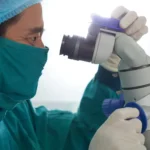Hemorrhoids affect millions of people, causing discomfort, bleeding, and disruption to daily life. While over-the-counter treatments and lifestyle changes provide relief for some, many individuals need more effective solutions to address persistent symptoms.
Infrared coagulation may be right for your hemorrhoids if you have grade 1 or 2 internal hemorrhoids and want a non-surgical treatment option that offers up to 95% effectiveness in symptom relief. This minimally invasive procedure uses infrared light to cut off blood supply to hemorrhoids, causing them to shrink and fall off within 7 to 10 days.
Understanding whether this treatment fits your specific situation requires examining how the procedure works, its benefits and limitations compared to other options, and what to expect during recovery. The decision depends on factors like hemorrhoid severity, previous treatment history, and individual health considerations.
What Is Infrared Coagulation and How Does It Treat Hemorrhoids?
Infrared coagulation (IRC) is a minimally invasive outpatient procedure that uses focused infrared light to cut off the blood supply to internal hemorrhoids. The heat creates scar tissue that causes hemorrhoidal tissue to shrink and eventually detach naturally.
How Infrared Coagulation Works
Infrared coagulation therapy targets the blood vessels feeding internal hemorrhoids through precise heat application. The infrared light generates temperatures that coagulate blood vessels within the hemorrhoidal tissue.
When the infrared photocoagulation device delivers concentrated heat, it causes the proteins in blood vessel walls to denature and stick together. This process effectively seals off the blood supply to the targeted hemorrhoid.
The coagulated vessels form scar tissue over the following days and weeks. This scarring process anchors the hemorrhoidal tissue to the rectal wall and prevents prolapse.
Without adequate blood flow, the hemorrhoid gradually shrinks in size. The treated tissue typically detaches and passes naturally within 7-10 days after the procedure.
The Procedure Step by Step
IRC treatment begins with the patient positioned for optimal access to the hemorrhoidal tissue. Most physicians use an anoscope to visualize internal hemorrhoids clearly during the procedure.
The doctor inserts a small infrared coagulation probe directly above the hemorrhoid base. The probe delivers controlled bursts of infrared light energy to the target area.
Key procedure elements:
- No anesthesia required for most patients
- Treatment duration: 10-15 minutes per session
- 1-3 hemorrhoids treated per visit
- Immediate return to normal activities
Patients typically feel only mild warmth during infrared light application. The minimally invasive procedure allows individuals to drive themselves home afterward.
Multiple treatment sessions may be necessary for larger hemorrhoids or when treating several hemorrhoids simultaneously.
Types of Hemorrhoids Treated by IRC
Infrared coagulation therapy works exclusively on internal hemorrhoids located above the dentate line. External hemorrhoids cannot be treated with this method due to their location and nerve supply.
IRC proves most effective for Grade I and Grade II internal hemorrhoids. Grade I hemorrhoids bleed but do not prolapse, while Grade II hemorrhoids prolapse during bowel movements but retract spontaneously.
Treatment suitability by hemorrhoid grade:
| Grade | Characteristics | IRC Effectiveness |
|---|---|---|
| Grade I | Bleeding, no prolapse | Excellent |
| Grade II | Prolapse with retraction | Very good |
| Grade III | Prolapse requiring manual reduction | Limited |
| Grade IV | Permanent prolapse | Not suitable |
Small to medium-sized internal hemorrhoids respond better to infrared coagulation than larger, more advanced cases. Physicians may recommend alternative treatments for Grade III and Grade IV hemorrhoids that require more aggressive intervention.
Benefits and Limitations of Infrared Coagulation
IRC offers several advantages as a minimally invasive treatment option, though it has specific limitations regarding effectiveness and potential recurrence. Understanding both aspects helps patients make informed decisions about their hemorrhoid treatment.
Key Advantages of IRC
IRC provides significant benefits compared to surgical hemorrhoidectomy and other invasive procedures. The treatment requires no anesthesia in most cases and can be completed in a doctor’s office within minutes.
Quick recovery time is one of IRC’s most appealing features. Most patients return to normal activities immediately after treatment. The procedure causes minimal discomfort during and after the session.
The less invasive nature of IRC eliminates surgical risks like infection, bleeding complications, or prolonged healing periods. Patients avoid the pain and extended downtime associated with traditional hemorrhoid surgery.
Key procedural advantages include:
- No incisions or sutures required
- Outpatient procedure with immediate discharge
- Can be combined with routine colonoscopy
- Minimal preparation needed
The treatment effectively reduces bleeding, irritation, and discomfort associated with internal hemorrhoids. Studies show significant symptom improvement after IRC sessions, making it a viable first-line treatment for appropriate candidates.
Possible Limitations and Recurrence
IRC works best for grade I and II internal hemorrhoids but has limitations for more severe cases. The procedure cannot treat external hemorrhoids or large prolapsing internal hemorrhoids effectively.
Recurrence rate varies among patients, particularly those who don’t address underlying causes. Hemorrhoids can recur if patients maintain poor dietary habits, chronic constipation, or prolonged sitting without lifestyle modifications.
Multiple treatment sessions are often necessary for optimal results. While some patients see improvement after one session, most require two to three treatments spaced several weeks apart for complete symptom resolution.
Treatment limitations include:
- Not suitable for grade III-IV hemorrhoids
- May require repeated sessions
- Temporary mild bleeding or discomfort possible
- Less effective than rubber band ligation in some cases
The procedure’s effectiveness depends heavily on proper patient selection and addressing contributing factors like diet and bowel habits.
Effectiveness and Success Rate
IRC demonstrates a high success rate for treating appropriate hemorrhoid grades, with studies showing up to 95% effectiveness in symptom relief. The treatment particularly excels at controlling bleeding and reducing hemorrhoid size.
Effective treatment outcomes depend on several factors including hemorrhoid grade, patient compliance with post-treatment care, and lifestyle modifications. Most patients experience significant symptom improvement within 7-10 days as treated tissue shrinks.
Success rates vary by hemorrhoid severity:
- Grade I hemorrhoids: 90-95% success rate
- Grade II hemorrhoids: 85-90% success rate
- Grade III hemorrhoids: 70-80% success rate (selected cases)
Long-term effectiveness improves when patients adopt high-fiber diets, increase fluid intake, and modify bathroom habits. Combining IRC with lifestyle changes reduces recurrence rates significantly compared to treatment alone.
Studies comparing IRC to other treatments show comparable effectiveness to rubber band ligation with better patient tolerance and comfort levels.
Candidacy and Comparison With Other Hemorrhoid Treatments
IRC works best for specific hemorrhoid grades and patient types, while other treatments like banding and hemorrhoidectomy serve different clinical needs. Treatment selection depends on hemorrhoid severity, patient health status, and symptom complexity.
Who Is a Good Candidate for IRC?
IRC is most effective for patients with grade I and II internal hemorrhoids. Small to medium-sized hemorrhoids respond best to this non-surgical treatment for hemorrhoids.
Ideal candidates include patients who want to avoid surgery and those with bleeding as their primary symptom. The procedure works well for individuals who cannot tolerate more invasive options due to health conditions.
Patients with grade III hemorrhoids may benefit from IRC, though results vary. Those seeking minimal downtime and quick recovery often prefer this approach.
IRC is not suitable for external hemorrhoids since the infrared light targets internal tissue only. Patients with thrombosed hemorrhoids or active infections should consider alternative treatments.
The procedure works best when hemorrhoids are not severely prolapsed. Patients with realistic expectations about potential recurrence rates tend to have better satisfaction with outcomes.
How IRC Compares to Banding and Hemorrhoidectomy
Rubber band ligation has lower recurrence rates than IRC but causes more post-procedure discomfort. Studies show IRC produces less severe pain compared to banding in the first week after treatment.
IRC allows faster return to work, typically 1-2 days versus 5+ days for hemorrhoidectomy. Bleeding complications occur in only 5% of IRC patients compared to 30% with surgical removal.
Hemorrhoidectomy provides the most definitive results for severe cases but requires longer recovery time. IRC offers comparable symptom relief for appropriate candidates without surgical risks.
| Treatment | Pain Level | Recovery Time | Recurrence Rate | Best For |
|---|---|---|---|---|
| IRC | Low | 1-2 days | Moderate | Grades I-II |
| Banding | Moderate | 3-5 days | Low | Grades II-III |
| Hemorrhoidectomy | High | 2-4 weeks | Very Low | Grade IV |
Cost considerations favor IRC due to shorter procedure times and reduced follow-up needs.
When to Consider Alternative Options
Patients with grade IV hemorrhoids should pursue hemorrhoidectomy rather than IRC. Severely prolapsed tissue requires more aggressive intervention for effective treatment of hemorrhoids.
Multiple failed IRC treatments indicate the need for rubber band ligation or surgical options. Recurrent bleeding after two IRC sessions suggests inadequate tissue response.
Patients with mixed internal and external hemorrhoids benefit from combination approaches or surgical management. IRC cannot address external components effectively.
Those experiencing persistent severe symptoms despite IRC may require evaluation for underlying conditions. Complex cases often need surgical consultation for optimal outcomes.
Risks, Recovery, and Preventing Hemorrhoid Recurrence
IRC carries minimal risks compared to surgical procedures, and most patients recover within days to weeks. Understanding potential complications and prevention strategies helps ensure the best outcomes and reduces the likelihood of hemorrhoid recurrence.
Common Risks and Side Effects of IRC
IRC is considered a low-risk procedure with complications occurring infrequently. The most common side effects include mild discomfort at the treatment site and temporary bleeding from the anus.
Immediate risks include:
- Minor bleeding during or after treatment
- Sensation of fullness in the rectum
- Temporary pain or cramping in the anal canal
Most patients experience minimal discomfort since the procedure targets tissue above the nerve-rich dentate line. Bleeding typically resolves within 24-48 hours and appears as small amounts of blood on toilet paper or in stool.
Rare complications may include:
- Infection at the treatment site
- Formation of thrombosed hemorrhoid
- Delayed bleeding requiring medical attention
The risk of complications increases in patients with bleeding disorders or those taking blood-thinning medications. Patients should discuss their medical history and current medications with their healthcare provider before treatment.
Unlike surgical hemorrhoidectomy, IRC does not require anesthesia beyond topical numbing, significantly reducing anesthesia-related risks.
What to Expect During Recovery
Recovery from IRC is typically straightforward with most patients returning to normal activities within 1-2 days. The treated tissue forms scar tissue over the following weeks, permanently reducing hemorrhoid size.
First 24-48 hours:
- Light bleeding or spotting is normal
- Mild discomfort during bowel movements
- Sensation of fullness may persist temporarily
Patients should avoid straining during bowel movements to prevent disrupting the healing process. Using stool softeners can help maintain comfortable bowel movements during recovery.
Week 1-2:
- Bleeding should decrease significantly
- Any itching around the treatment area typically resolves
- Normal bowel function returns
Complete healing:
- Full recovery occurs within 2-4 weeks
- Scar tissue formation cuts off blood supply to treated hemorrhoids
- Symptoms like bleeding and prolapse should improve markedly
Patients should contact their healthcare provider if they experience heavy bleeding, severe pain, or signs of infection during recovery.
Tips for Preventing Future Hemorrhoids
Prevention strategies focus on reducing pressure on rectal veins and maintaining healthy bowel habits. Dietary and lifestyle modifications prove most effective in preventing hemorrhoid recurrence.
Dietary modifications:
- Increase daily fiber intake to 25-35 grams
- Add fiber supplements if dietary fiber proves insufficient
- Drink adequate water to soften stool naturally
- Limit processed foods that contribute to constipation
Bowel habit improvements:
- Avoid straining during bowel movements
- Do not delay bowel movements when feeling the urge
- Limit time spent sitting on the toilet
- Use stool softeners if recommended by healthcare providers
Lifestyle changes:
- Exercise regularly to improve circulation
- Avoid prolonged sitting or standing
- Maintain healthy body weight
- Practice proper lifting techniques
Risk factors to address:
- Chronic constipation requiring medical management
- Pregnancy-related pressure increases
- Occupational factors involving heavy lifting
These prevention strategies become particularly important since IRC treats existing hemorrhoids but does not prevent new ones from developing. Patients who maintain these habits typically experience lower recurrence rates and better long-term outcomes.
Frequently Asked Questions
Patients considering infrared coagulation often have concerns about side effects, costs, treatment limitations, and recovery expectations. The procedure’s effectiveness varies based on hemorrhoid type and severity.
What are the potential side effects of infrared coagulation for treating hemorrhoids?
Minor bleeding, rectal discomfort, and temporary urgency for bowel movements are the most common side effects, while serious complications like infection remain extremely rare.
How does the cost of infrared coagulation for hemorrhoids compare to other treatments?
IRC typically costs less than surgical hemorrhoidectomy and is often covered by insurance, making it more affordable than invasive surgical options while being more expensive than topical treatments.
Can infrared coagulation effectively treat external hemorrhoids?
No, infrared coagulation is designed exclusively for internal hemorrhoids and cannot treat external hemorrhoids effectively.
What is the typical recovery time after undergoing infrared coagulation treatment?
Most patients return to normal activities the same day or within 24 hours, with mild discomfort lasting one to two days.
How does infrared coagulation compare to rubber band ligation in the treatment of hemorrhoids?
IRC causes less post-procedure pain than rubber band ligation but may require more treatment sessions to achieve similar results for Grade II hemorrhoids.
Is there any pain associated with the infrared coagulation procedure for hemorrhoids?
The procedure causes minimal discomfort, with most patients experiencing only mild pressure or warmth during the 1-2 second application of infrared energy.







